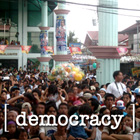
|
NEPAL PARLIAMENT SWORN IN UNDER NEW PRIME MINISTER
30 April 2006 After King Gyanendra declared he would reinstate the lower house of parliament, which he disbanded, claiming a state of emergency in his war to put down Maoist insurgents, agreements were reached with the 7-party alliance of mainstream opposition parties which had staged the massive and growing demonstrations. That 7-party alliance reconvened parliament on Friday and today swore in its interim Prime Minister, who will oversee the vote and negotiations to draft a new constitution. It is believed that the parliament may claim the power to dissolve the monarchy, whether or not it takes that step in the immediate future, relegating Gyanendra to a symbolic role. This speculation comes as Maoist insurgents, who have declared a 3-month ceasefire to let democracy take its course, have now said they will capture and execute the king "in the name of the people" if he does not go voluntarily or is not sent by parliamentary order, into exile. Massive street celebrations accompanied the reconvening of parliament and the swearing in of the new PM. The small Himalayan country, at the world's highest altitude, for now looks to have avoided the potentially bloody consequences of a protracted popular upheaval, during which government responses took 18 lives. [s]
BACKGROUND: The opposition movement in Nepal has captured the attention of the world press, in part because of the extremes involved in the situation. Many poor people putting their lives at risk to demonstrate against an absolutist monarch. The highest places in the world, extreme weather, and high stakes, as pro-democracy activists seek to forge a way out of authoritarianism, while Maoist rebels seek a communist regime and the king seeks to hold onto power. [Full Story] |
||||||
|
|||||||


